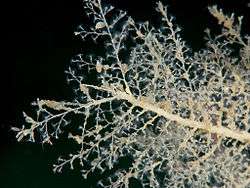Leptomedusae
| Thecate hydroids | |
|---|---|
 | |
| Crystal Jelly (Aequorea victoria, Conica: Aequoreidae) with the parasitic amphipod Hyperia medusarum | |
| Scientific classification | |
| Kingdom: | Animalia |
| Phylum: | Cnidaria |
| Class: | Hydrozoa |
| Subclass: | Leptolinae |
| Order: | Leptomedusae Haeckel, 1879 |
| Suborders | |
|
Conica | |
| Synonyms | |
|
Leptomedusa Haeckel, 1879 | |
Leptomedusae or Leptomedusa, commonly called thecate hydroids, are a cnidarian order in the subclass Leptolinae. They were formerly placed at suborder rank in the paraphyletic "Hydroida". Their closest living relatives, according to the modern view, are the Anthomedusae which are similar enough to have always been considered closely related, and the very apomorphic Siphonophora which were placed outside the "Hydroida". Given that there are no firm rules for synonymy for high-ranked taxa, alternative names like Leptothecata, Thecaphora or Thecata, with or without the ending emended to "-ae", are also often used for the Leptomedusae.[1] World Hydrozoan Database currently uses the name Leptothecata.[2]

The about 1,900 species of Leptomedusae are characterized by a number of features: Their polyps are always living in colonies with the hydranths set in hydrotheca which are usually permanent and often long enough so the animal can fully retract into it; some have very reduced hydrothecae resembling Anthomedusae. There is a single whorl of tentacles.
The gonophores are borne on much reduced hydranths and usually protected in a peridermal gonotheca. Medusae forming on fully developed hydranths are extremely rare; usually the gonophores develop into medusae or into sessile sporosacs. The medusae have a shallow bell, bear the gonads on their radial canals, and usually have statocysts which are formed only from epidermal tissue and more than four tentacles and. The cnidome never has stenoteles.
Notable Leptomedusae include:
- Air fern (Sertularia argentea) of the Sertulariidae, sold dried as novelty "plants" and aquarium ornaments
- Crystal jelly (Aequorea victoria) of the Aequoreidae, a bioluminescent hydrozoan
- Obelia of the Campanulariidae
Systematics[3]
ORDER LEPTOMEDUSAE
- Basal and incertae sedis
- Family Eucopidae
- Suborder Conica
- A large number of Families of uncertain affiliations are listed here
- Superfamily Campanulinoidea (disputed)
- Superfamily Plumularioidea
- Superfamily Sertularioidea
- Suborder Proboscidoidea
- Family Bonneviellidae
- Family Campanulariidae
- Family Phialuciidae
References
- ↑ Schuchert (2005a)
- ↑ Schuchert, P. (2014). Leptothecata. In: Schuchert, P. (2014) World Hydrozoa database. Accessed through: Schuchert, P. (2014) World Hydrozoa database at http://www.marinespecies.org/hydrozoa/aphia.php?p=taxdetails&id=13552 on 2014-10-31
- ↑ Schuchert (2005b), MarineSpecies.org (2008)
| Wikimedia Commons has media related to Leptomedusae. |
- MarineSpecies.org (2008): Leptomedusae. Retrieved 2008-JUL-08.
- Schuchert, Peter (2005a): The Hydrozoa Directory - Hydrozoan Phylogeny and Classification. Retrieved 2008-JUL-08.
- Schuchert, Peter (2005b): The Hydrozoa Directory - Order Leptomedusae Haeckel, 1879. Retrieved 2008-JUL-08.